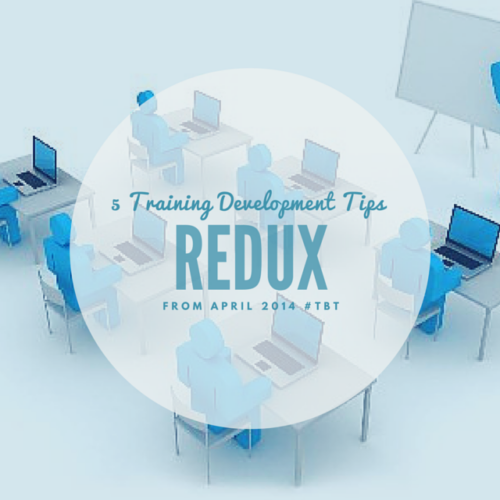My Top 5 Training Development Tips Redux #tbt
 Introduction
Introduction
Today I’d like to highlight some posts from last year. It’s my version of Throwback Thursday, or #tbt, in blog form. Back in April 2014 I shared these 5 tips after just leaving my job as Director of Training. So the realities of corporate training were fresh. As I reread this post I notice there are some good tips embedded inside each of the 5 tips. So, you’re getting a lot more than 5. I hope you find them useful and will share your thoughts with me via twitter @Litmos or @bschlenker.
The world of Corporate Training is really not that complicated. But with all of our instructional models and frameworks, we like making it a little more complicated than others believe it to be. There are situations where all the detailed processes of instructional design are required. But, in my experience, those projects are rare. The perceptions others have of your work is critical to your success. Here are my top 5 development tips that will increase your perceived value within your company and amongst your team.
Done is Better than Perfect!
There is a good reason why this quote is so popular. IT’S TRUE! And it’s one of the most important lessons I’ve learned in my career.
As a young recent graduate of the Educational Media and Computers Masters program at ASU, I was perfectly prepared to employ everything I had learned at my first full time job. I was ready to implement the ADDIE model in all its glory. Imagine my surprise when my manager asked that my first eLearning course be created in 5 days. It was a project that framed the rest of my eLearning career, and was also my first experience with “the business” and what they expected from the training department.
The business does not care about instructional design, analysis, evaluation, and all the other stuff we like to spend so much time on. In most cases they just want content that is easily accessed and proof that all employees have “taken the course”. So, get the minimum done and release it. You can always go back and improve once you start receiving user feedback.
And of course, these days, your tools and systems should be doing most of the heavy lifting around evaluation and analysis anyways. If not, maybe it’s time for a new LMS.
UPDATE: This still stands. If you aren’t happy with your tools then figure out how to get new ones. And get the job done. You will discover that your skills are pretty solid and the final product is pretty good, even if it’s not the polished solution you had in mind. Produce business value!
Use the Tools You Have Now!
The computer, and other technologies, that you have are good enough. Instead of thinking about all the gear you don’t have, figure out how to use everything you have now.
If you have a late model smartphone, then you have a powerful multimedia production studio in the palm of your hand. And that corporate issued laptop may not be the multimedia development power house you’ve been dreaming of, but it does have enough power to create most of the digital content elements you need. I was developing fully interactive 3D training simulations in 1996 on computers with only a fraction of what today’s computers have. Don’t make technology your excuse for not producing.
Your company has an LMS with authoring capabilities…or an authoring tool in general. However, you still need to create media or modify stock media. All eLearning starts with digital media content. Photoshop is pricey, but there are options…some of which are free. Figure out how to get the job done with the tools you have. And don’t forget to devote time to improving your skills with those tools.
UPDATE: This tip is still valid. You have more tools today than any training professional before you. Those who master the tools get the jobs. Don’t be afraid to practice, practice, practice. If you are interested in learning about video and practicing with video in social media then join me on Fridays for Video Friday. Just follow the hashtag #vidfri and join others learning and sharing their video tips.
Templates are your Friend. Use them!
Yes, for the perfectionist in all of us templates are the ultimate sin. Using templates somehow minimizes the instructional design process for us. But having a few ready to go will save you time, and make you look like a hero. Just think of it as working smarter, not harder.
You often don’t have the luxury of time, and templates will help you get courses done faster (see #1). That course may not end up being the one you submit for an award, but “the business” will care and respect your ability to produce…fast.
UPDATE: You’ll notice that I talk about providing business value frequently. Most of my obsession with providing business value just comes from experience. The experiences of training departments that do good work and yet, not get recognized, viewed as a pricey expense, or even disbanded. Some of my colleagues argue there is more business value in pushing back and saying no, than just getting the job done and showing an iterative, progression of improvements. You are the only one that can decide what your organization can tolerate. And this is why relationships are important.
Leverage Your Subject Matter Experts
Subject Matter Experts are passionate about what they do…that’s why they are SMEs. And most, not all but most, are happy to share what they know. Let them. And get out of their way. Do not try to make them follow your instructional model. Do not force them to use your template or framework. Leave them alone. UNLESS, they ask for your help or are struggling getting started. Then, and only then, offer up some possible templates or other design options.
Hopefully you’ve built a relationship with your SMEs and already have a feeling for how to approach them with new ideas. Respect what they do, and let them discover their instructional shortcomings through experience. Then help them improve.
UPDATE: I’ve focused a lot on SMEs in my posts over the last year. And I think that’s because it took many years of treating them like content ATMs before I realized how wrong I was. I was always taught that you needed a subject matter expert in order to get the content you need to create your eLearning master piece. But nobody ever taught us how to treat them like people. And that there would be egos, and corporate politics involved.
I know my thoughts on releasing training that is not fully designed is controversial. But it comes from years of real world frustrations working with SMEs, and through trial and error discovering how best to get the job done while building a strong relationship. And THEN updating the course with instructionaly sound updates to the content. Relationships are the key to 21st century training departments because there is no such thing as “one-and-done” any more.
Master Your LMS
No, you’re not reading this wrong. And yes, these tips are for anyone developing and delivering training content. Even if you have an LMS administrator on your team, you should be fully aware of how it works including it’s quirks and shortcomings. How you develop your content will always be influenced by the capabilities of your LMS. So, don’t just use it. MASTER it! It will save you precious development time, and reduce your LMS related headaches when it’s time to deliver.
What have you learned, the hard way, in your career?

 Introduction
Introduction



